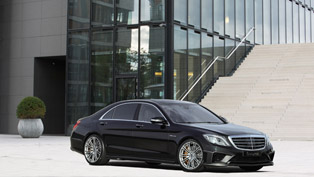The 90 hp Mercedes Simplex, Camille Jenatzy and the 1903 Gordon Bennett Trophy
It was in 1901 that Daimler-Motoren-Gesellschaft (DMG), the company founded in 1890, delivered the now legendary first 35 hp Mercedes to Emil Jellinek; designer Wilhelm Maybach then immediately set about turning his thoughts to the future. At the top of his list of priorities were a higher power output, greater operational convenience and increased reliability, which even in those days were hallmarks of Daimler vehicles. And so it came about that the engine of the Mercedes "Simplex" from 1902 already developed 40 hp (29 kW) and was easier to drive, as its name indicates.
For the year 1903, Maybach had envisaged an even more powerful engine, since DMG wanted at last to vie for the prestigious Gordon Bennett Trophy: The image boost that the company had been gaining through the Mercedes' monumental success was to be underscored by illustrious racing victories.
The Gordon Bennett Trophy
The Gordon Bennett Trophy race, which had been established in late 1899 by James Gordon Bennett, the Paris-based American publisher and editor-in-chief of the "New York Herald", was the most distinguished motor racing event of its day – a veritable race of the nations. This event, staged once a year, was something of a forerunner of today's Grand Prix races. Gordon Bennett had also proposed uniform regulations for the first time. The participating vehicles, for example, were to weigh at least 400, but no more than 1,000 kilograms. They were required to be manufactured in the country they represented – right down to the last washer and bolt. This rule was strictly enforced, and the Mercedes cars felt the effects in 1903: While the Michelin tires were provided by a company manufacturing under license in Germany, this could not be said of their valves. The cars were therefore refitted with Continental tires.
The race was organized in much the same way as the traditional America's Cup sailing regatta, the winner receiving a challenge cup that Gordon Bennett had donated to the Automobil Club de France. Each participating nation could enter up to three vehicles. The country of the winning vehicle had the honor of organizing and staging the following year's event.
In 1902, the race was won by S. F. Edge in a Napier – an Englishman, and so the 1903 event would normally have been staged in England. However, since road races were not permitted in that country, the Automobile Club of Great Britain and Ireland had no option but to stage the race on the "emerald isle".
The 90 hp bolide from Mercedes
In order to put up a good showing in this race especially against the strong competition from France, the Mercedes cars required an exceptional engine, which Maybach developed within a very short time on the basis of the 40 hp (29 kW) unit from the Simplex. It was provided in two "sizes" and thus in two power categories: a 9.2 liter engine officially developing 60 hp (44 kW) at 1,100 rpm – but which actually reached a good 65 hp (48 kW) – and a 12.7 liter unit developing 90 hp (66 kW) at 1,200 rpm.
These four-cylinder engines each included overhead inlet valves, lateral outlet valves and dual camshafts – a design that was also to be found in the Mercedes engines from the ensuing years. The low-voltage magneto ignition with contact points in the combustion chamber was supplemented by a high-voltage unit incorporating standard spark plugs.
A new feature were the inlet valves, which in addition to the element mechanically displaced by the camshaft also included an automatic "snifting valve" of rather adventurous design. Although these valves required highly precise matching to their doubly centered seats, they never once gave cause for complaint. The objective of their highly characteristic design was to achieve maximum filling of the cylinders.
The cooling power of the exemplary honeycomb radiator, which had proved reliable since the time of the very first Mercedes, was further increased by means of a series of fine grooves on the coolant tubes. The effective surface area was thereby increased to such an extent that the same quantity of water could be used to cool a considerably more powerful engine.
In their dimensions, the chassis and running gear corresponded to the Simplex, only that its track width was somewhat narrower; this also made for a more slender body. The decidedly sporty Simplex bodies were produced with the accustomed reliability by the Christian Auer company in Cannstatt. The new cars' most salient feature was their front section with its characteristically formed roof-shaped radiator top and a correspondingly styled aluminum hood. The rest of the body consisted of a bulkhead with an oil sight glass and a simple platform, on which the driver's and passenger's bucket seats were mounted and to the rear of which the spare wheels were strapped.
The fire at DMG's Cannstatt plant
The Mercedes-Simplex 60 hp attracted mainly private buyers, who were able to pick up their vehicles at Untertürkheim, DMG's as yet unfinished new plant. The three 90 hp bolides for the Gordon Bennett race were set to be loaded onto a railway wagon at the DMG plant on Seelberg hill in Cannstatt. However, their career came to an end before it had even begun: At half past two in the morning of June 10, 1903, a devastating fire broke out in the factory, destroying the production facilities along with ninety vehicles, many of which were complete – including the three race cars.
Even today, DMG's reaction to this disaster makes quite dramatic reading in itself: 1. No workers were dismissed, with production continuing temporarily in rented workshops. 2. With dual-shift operations, construction of the new plant in Untertürkheim was expedited to such an extent that the move from Cannstatt to Untertürkheim was complete by 1904, a year ahead of schedule. 3. For the forthcoming race on July 2, 2003, DMG purchased or borrowed three of the 60 hp Mercedes Simplex cars from private owners, so it was able to participate in the event in Ireland in spite of events.
Camille Jenatzy skids his way to victory
The Mercedes cars chosen were modified for the race in record time, given a thorough check-up once more and painted white, the German racing color. DMG had won over the internationally renowned and successful Belgian Baron Pierre de Caters and the American Foxhall Keene as drivers – as well as assigning the car of the millionaire American automobile enthusiast Clarence Clay Dinsmore, who had generously made his vehicle available free of charge, to the Belgian driver Camille Jenatzy.
There was no longer sufficient time to dispatch the cars to Ireland by rail, so they were driven through France to the race circuit near Dublin under their own power, arriving safe and sound a day and a half prior to the event.
Most races at the time were staged as "city to city" events; but the 1903 Gordon Bennett Trophy race made a new departure, with two circuits 65 and 83 kilometers in length being used in alternation.
Camille Jenatzy, born in Brussels in 1868, was on the one hand a down-to-earth engineer, but on the other hand a race driver obsessed with speed. He achieved fame with his red beard and by becoming the first person to break the 100 km/h barrier – in April 1899 at the wheel of an electrically powered car by the name of "La Jamais Contente" (the never-contented).
On that cool and cloudy day, July 2, 1903, Jenatzy drove the race of his life on a track riddled with curves and bumps. At the wheel of a car that was inferior in terms of engine power – at least on paper – he commanded the field with his undaunted, spectacular driving style and by virtue of the fact that he knew just how to put the immense torque of his four-cylinder engine to best effect when accelerating out of curves. He also benefited from the relatively low weight of his Mercedes by comparison with his competitors' vehicles.
A participant marveled: "Throughout the seemingly endless series of curves, Jenatzy kept his foot to the floor. He skidded at breakneck speed around the corners, often only narrowly missing the bordering walls in the process, as was shown by his skid marks that were everywhere to be seen. I could not imagine that he could keep up this daredevil driving style for very long."
But keep it up he did, unlike his two teammates; and his Mercedes bearing the number 4 was the first across the line. He had won this noteworthy race, in the face of competition from more powerful cars, at an average speed of 79.24 km/h.
This was not just a victory for Jenatzy, but above all a victory and indeed a first major international success for the Mercedes brand, which had now finally established itself in the elite of racing nations the likes of England or France – a status that the brand with the three-pointed star maintained through the amalgamation with Benz into Mercedes-Benz, and has faithfully upheld to this very day.
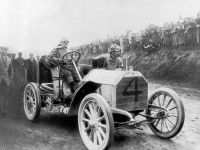
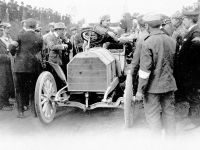
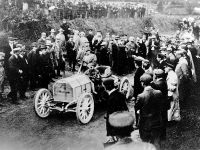
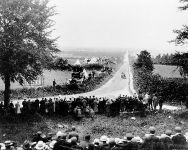

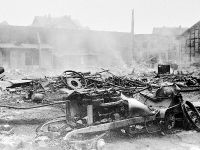
![2015 Mercedes-Benz S-Class Coupe [official image]](http://www.automobilesreview.com/uploads/2014/02/2015-Mercedes-Benz-S-Class-Coupe-b.jpg)

